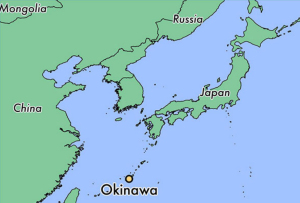The Birthplace of Karate and Kobudo
Okinawa is the birthplace of karate and kobudō. Historically practiced in secret, karate and kobudō were once little known, even on the island of Okinawa. Karate gained in popularity and spread throughout the world after the end of World War II. Indeed, karate might be considered Okinawa’s greatest export. Kobudō, the study of the humble weapons of ancient Okinawa, has never achieved the popularity of karate, but its practice has gained steadily in recent years.
Where in the World Is Okinawa?
Okinawa is the largest island in a group of islands that make up the Okinawa Prefecture of Japan. A prefecture is a political entity much like a state in the U.S. The island of Okinawa is 70 miles long and 7 miles wide. By comparison, the state of Hawaii is 23 times as large as Okinawa Prefecture.
The islands of the Okinawa Prefecture are part of the Ryūkyū Islands, a group of islands in the East China Sea that stretch from Kyūshū, the southernmost of the main islands of Japan southwest to Taiwan. The Ryūkyū Islands are coral in origin. The soil is poor and metals are scarce.
The island of Okinawa is subtropical, growing sugar cane, pineapples and cut flowers, most notably orchids. It is subject to numerous typhoons during the typhoon season, which peaks in August and September. Since a typhoon loses power as it travels northward, typhoons that reach land in Okinawa are typically more powerful than typhoons that hit the more-northern main islands of Japan.
How The History of Okinawa
Shaped Karate and Kobudo
For its small size, Okinawa has enjoyed a colorful history. Like Hawaii, Okinawa was once an independent country. That country was called the Ryūkyū Kingdom. Throughout much of its history the Ryūkyū Kingdom was dominated culturally and economically by both China and Japan. The history of karate and its lesser known cousin, kobudō (the weapons of ancient Okinawa), is inseparable from the history of the tiny island kingdom of Ryūkyū.

Southern-most Main Island of Japan
Ancient History
The exact origin of the peoples who first settled the Ryūkyū Islands is clouded by time and legend, as is the shadowy origin of an indigenous form of hand-to-hand combat featuring striking, kicking and grappling – a fighting art reported as early as the sixth century. Indeed, karate-like movements can still be seen in traditional Okinawan dances passed down from times before recorded history. Over the centuries, honed by many cultural and historical influences, this indigenous fighting art gradually developed into the karate of today.